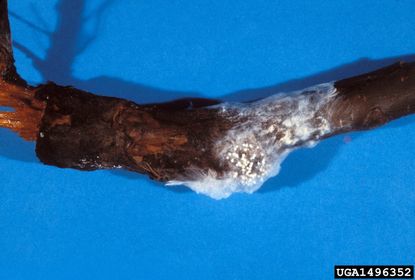Southern Blight Apple Treatment: Recognizing Southern Blight In Apple Trees


Southern blight is a fungal disease affecting apple trees. It’s also known as crown rot and is sometimes called white mold. It is caused by the fungus Sclerotium rolfsii. If you are interested in learning about southern blight in apple trees and southern blight apple treatment, read on.
Southern Blight of Apples
For years, scientists thought that southern blight in apple trees was only a problem in warm climates. They believed that the fungus structures that overwinter were not cold hardy. However, this is no longer considered true. Gardeners in Illinois, Iowa, Minnesota, and Michigan have reported incidents of southern blight of apples. It is now known that the fungus can survive winter cold, especially when it is covered up and protected by layers of snow or mulch. The disease is mostly an issue in apple growing areas in the Southeast. Although the disease is often called southern blight of apples, apple trees are not the only hosts. The fungus can live on some 200 different types of plants. These also include field crops and ornamentals like:
Symptoms of Southern Blight in Apple Trees
The first signs that you have apple trees with southern blight are beige or yellow, web-like rhizomorphs. These growths appear on the lower stems and roots of the trees. The fungus attacks the lower branches and the roots of apple trees. It kills the tree’s bark, which girdles the tree. By the time you notice that you have apple trees with southern blight, the trees are on their way to dying. Typically, when trees get southern blight of apples, they die within two or three weeks after the symptoms appear.
Southern Blight Apple Treatment
So far, no chemicals have been approved for southern blight apple treatment. But you can take steps to limit your tree’s exposure to southern blight of apples. Reduce losses from apple trees with southern blight by taking a few cultural steps.
- Burying all organic material may help since the fungus grow on organic material in the soil.
- You should also regularly remove weeds near the apple trees, including crop residue. The fungus can attack growing plants.
- You can also select the apple stock most resistant to the disease. One to consider is M.9.
Gardening tips, videos, info and more delivered right to your inbox!
Sign up for the Gardening Know How newsletter today and receive a free download of our most popular eBook "How to Grow Delicious Tomatoes."

Teo Spengler has been gardening for 30 years. She is a docent at the San Francisco Botanical Garden. Her passion is trees, 250 of which she has planted on her land in France.
-
 Clever Vertical Vegetable Garden Ideas For Small Spaces – 7 Ways To Save Space
Clever Vertical Vegetable Garden Ideas For Small Spaces – 7 Ways To Save SpaceShort on garden space? Learn some vegetable garden ideas for small spaces that are fun and easy.
By Mary Ellen Ellis
-
 26 Different Types Of Orchids – With Pictures & Information
26 Different Types Of Orchids – With Pictures & InformationDiscover stunning orchid types to grow in your home and garden – from easy beginner varieties to rare and exotic species that are the preserve of experts.
By Melanie Griffiths